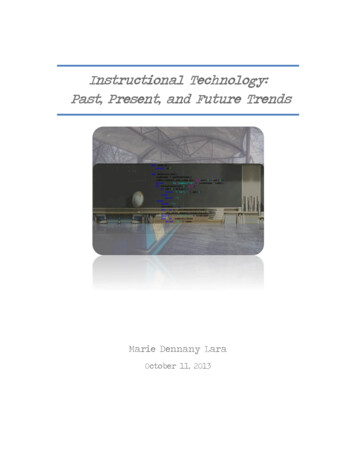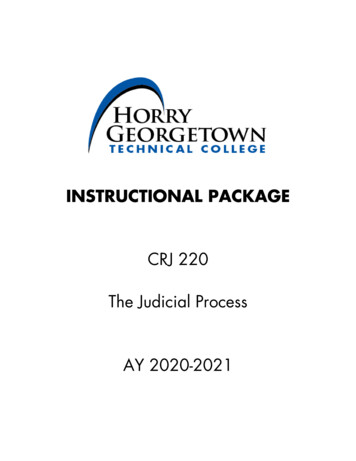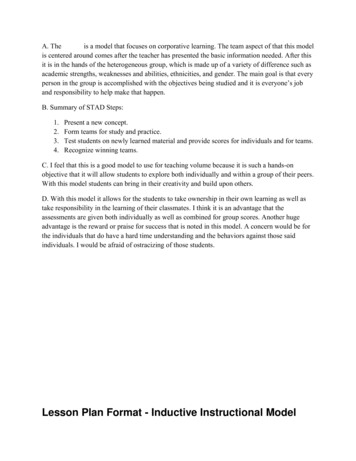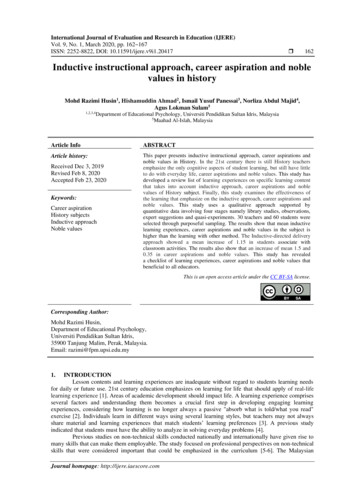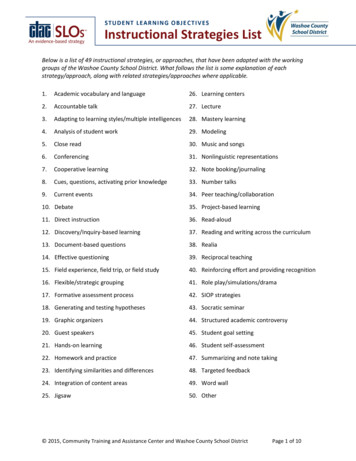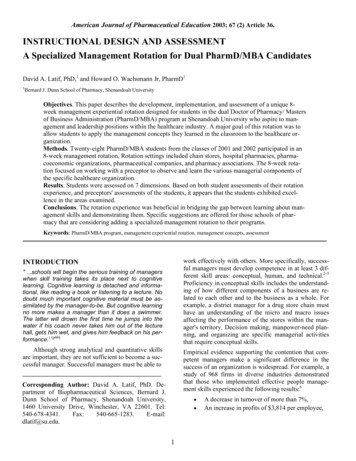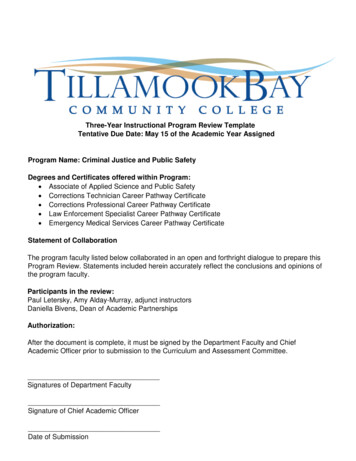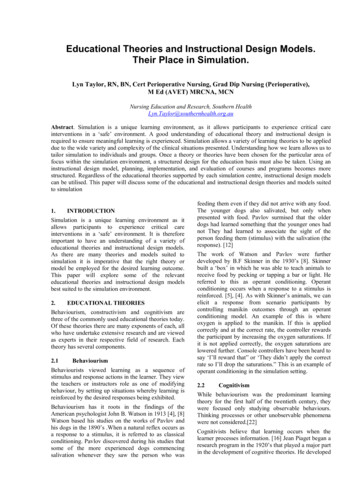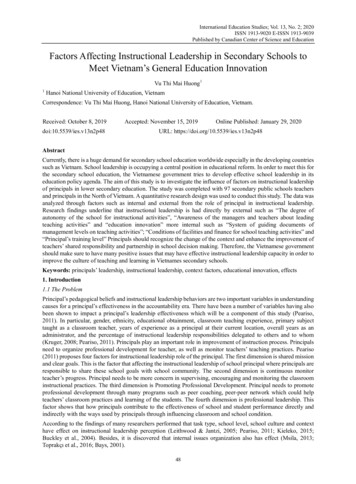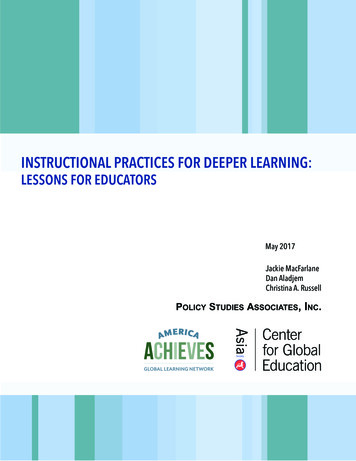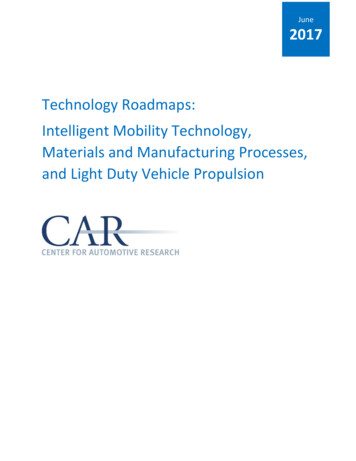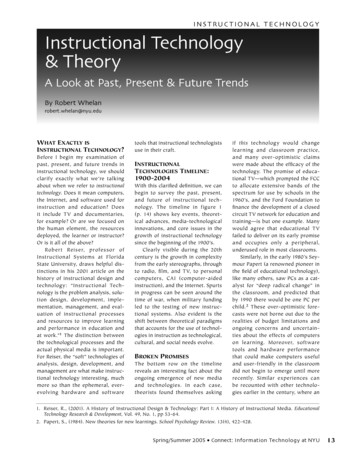
Transcription
INS TRUC TIONAL TECHNOLOGYInstructional Technology& TheoryA Look at Past, Present & Future TrendsBy Robert Whelanrobert.whelan@nyu.eduWHAT EXACTLY ISINSTRUCTIONAL TECHNOLOGY?Before I begin my examination ofpast, present, and future trends ininstructional technology, we shouldclarify exactly what we’re talkingabout when we refer to instructionaltechnology. Does it mean computers,the Internet, and software used forinstruction and education? Doesit include TV and documentaries,for example? Or are we focused onthe human element, the resourcesdeployed, the learner or instructor?Or is it all of the above?Robert Reiser, professor ofInstructional Systems at FloridaState University, draws helpful distinctions in his 2001 article on thehistory of instructional design andtechnology: “Instructional Technology is the problem analysis, solution design, development, implementation, management, and evaluation of instructional processesand resources to improve learningand performance in education andat work.”1 The distinction betweenthe technological processes and theactual physical media is important.For Reiser, the “soft” technologies ofanalysis, design, development, andmanagement are what make instructional technology interesting, muchmore so than the ephemeral, everevolving hardware and softwaretools that instructional technologistsuse in their craft.INSTRUCTIONALTECHNOLOGIES TIMELINE:1900-2004With this clarified definition, we canbegin to survey the past, present,and future of instructional technology. The timeline in figure 1(p. 14) shows key events, theoretical advances, media-technologicalinnovations, and core issues in thegrowth of instructional technologysince the beginning of the 1900’s.Clearly visible during the 20thcentury is the growth in complexityfrom the early stereographs, throughto radio, film, and TV, to personalcomputers, CAI (computer-aidedinstruction), and the Internet. Spurtsin progress can be seen around thetime of war, when military fundingled to the testing of new instructional systems. Also evident is theshift between theoretical paradigmsthat accounts for the use of technologies in instruction as technological,cultural, and social needs evolve.BROKEN PROMISESThe bottom row on the timelinereveals an interesting fact about theongoing emergence of new mediaand technologies. In each case,theorists found themselves askingif this technology would changelearning and classroom practice,and many over-optimistic claimswere made about the efficacy of thetechnology. The promise of educational TV—which prompted the FCCto allocate extensive bands of thespectrum for use by schools in the1960’s, and the Ford Foundation tofinance the development of a closedcircuit TV network for education andtraining—is but one example. Manywould agree that educational TVfailed to deliver on its early promiseand occupies only a peripheral,underused role in most classrooms.Similarly, in the early 1980’s Seymour Papert (a renowned pioneer inthe field of educational technology),like many others, saw PCs as a catalyst for “deep radical change” inthe classroom, and predicted thatby 1990 there would be one PC perchild.2 These over-optimistic forecasts were not borne out due to therealities of budget limitations andongoing concerns and uncertainties about the effects of computerson learning. Moreover, softwaretools and hardware performancethat could make computers usefuland user-friendly in the classroomdid not begin to emerge until morerecently. Similar experiences canbe recounted with other technologies earlier in the century, where an1. Reiser, R., (2001). A History of Instructional Design & Technology: Part I: A History of Instructional Media. EducationalTechnology Research & Development, Vol. 49, No. 1, pp 53-64.2. Papert, S., (1984). New theories for new learnings. School Psychology Review. 13(4), 422-428.Spring/Summer 2005 Connect: Information Technology at NYU13
Figure 1. This timeline shows some of the most influential technologies, theories, trends, and factors ininstructional technology in the last century.3initial enthusiasm about a particularform of media proved to be premature once attempts were made toincorporate the technology into theunforgiving realities of the classroom.Having looked back, we can now ask:is the World Wide Web, which seemsto hold so much promise for educators and learners, destined for thesame disappointment and obsolescence as the Magic Lantern, educational radio, and the standalone PC?20TH CENTURY LEARNINGTHEORIES 101Before considering this question,we can find another perspectiveon the past, present, and futuretrends in instructional technologyby reviewing the most influentiallearning theories that helped forminstructional technology over thelast 100 years.There are three principal familiesof theories about learning: behaviorism, cognitivism, and constructivism. Behaviorism emphasizesobservable behavior, rather thaninner mental experiences. Fromour environment, we learn certainbehaviors while learning not to doothers. Behaviorism is also thoughtof in terms of association building,and the “drill and practice” soft-ware often used in skill-building isan example of behavioristic instructional technology design. Behaviorism is sometimes critiqued asbeing too passive and mechanistic.Cognitivism, on the other hand,emphasizes the importance of perception, learning, and thought asbases for understanding humanbehavior and learning. Rooted ininformation processing theory pioneered in the 1960s, cognitivismdraws from the analogy betweencomputers and minds, allowing forthe possibility of computer programsthat “think” alongside their humanusers. Cognitivistic instructionaldesign is characterized by analyticbreakdown of a topic or subjectmatter, and the transformation ofthe subject matter into a set of structured cognitive tasks. Cognitivisticframeworks can include discoverytasks, problem diagnosis, and troubleshooting; Papert’s LOGO-basedlearning tools are considered cognitivistic. In these frameworks, knowledge acquisition is seen as an active,learner-driven outcome, much moreso than with behaviorism.An even more active view oflearning can be found in the theoryof constructivism. In this philosophy, first described over 100 yearsago, learning is seen as a processof knowledge construction wherethe learner is in charge of his or herown learning experience. Experience, combined with reflection andsocial interaction, allows the learnerto build on prior knowledge andcreate their own understanding ofideas and concepts. An example of aconstructivist learning environmentonline is a WebQuest, an inquirybased activity where the informationused by learners is drawn from theWeb.4 WebQuests use informationto solve problems or gain deeperinsights, and to support learners’thinking in terms of analysis, synthesis, and evaluation. In this way,meaningful mental models can beformed, and learners can select andintegrate their own schemas in orderto make sense of the world.While behaviorism is characterized by a linear, stimulus-responseapproach to learning, cognitivismlikens the mind of the learner to anelaborate information processingsystem. Constructivism, by contrast,puts the learner in charge of theirown search for meaning.The main point here is that whenwe survey the history of instructional media, we can see a mappingbetween these theories of learning3. Timeline graphic created by the author, drawing from the Reiser article referenced in footnote 1.4. http://webquest.org/14Connect: Information Technology at NYU Spring/Summer 2005
nology that needs to be furthercultivated, especially from theEU’s social policy perspective.With this sense of the theoretical background of instructionaltechnology, and this broad visionof its future, let’s focus now on thepresent, and on some key trends ininfrastructure, content development,and research in the field.A VISION OF THE FUTUREFigure 2. Will the World Wide Web one day go the way of the Magic Lantern,one of many technologies that didn’t live up to their initial promise?and the use of different types ofmedia. For example, behaviorism,which was at its height in the firsthalf of the last century, was complemented by linear media such asradio, film, and TV. Cognitivism,which was at its height in the 1960’sto 1980’s, was complemented by anew generation of desktop and personal computing, which found itsultimate expression in artificial intelligence (AI) and AI tutoring systemsresearch.Although behavioristic in manyways, these cognitivist systems stillrepresented a different paradigmfrom both behaviorism and constructivism. Constructivism in itscurrent incarnation is complementedby media and technologies that offerlearners multiple perspectives, formats, and options for sharing andexpressing their ideas. Thus, theWeb, having emerged in the mid90’s, with its networked, interactiveenvironments, accessible throughportable and handheld devices,offers functionality that goes beyondbehavioristic or cognitivistic worldviews, and recasts learning as aubiquitous, experiential, self-drivenactivity.THE EUROPEAN VIEWPOINTUnique economic, geographic,social, technological, and intellectual structures in the US have consistently helped give rise to revolutionsin the way media is used in learning.However, across the Atlantic,European Union (EU) researchand technological development ininstruction—often referred to as“E-learning”—have been followinga blueprint that both draws fromthe US experience and integratesEuropean culture and ambitions.The focus is on cultivating improvedefficiency in learning and cost-effectiveness, while deploying instructional technologies that betteraddress the needs of individuals,groups, and organizations.The European effort is helpfulfor understanding the current statusand future direction of instructionaltechnology because it leaves less tochance than the entrepreneuriallydriven American environment, andfollows instead a more programmatic approach.Core concepts in the vision of thefuture of E-learning in Europe are:1. Universal access to open, ubiquitous, experiential, and contextualized learning materials;2. The combination of advancedcognitive science and knowledge-based approaches with newmedia, including virtual and augmented reality, virtual presencetechnologies, and simulations;3. The ability to learn and seektraining, independent of time,place, and pace as a fundamentalaffordance of instructional tech-As more and more learning takesplace online or with the support ofInternet-based resources and tools,the “E” in E-learning is likely to bepresumed and taken for granted.Fewer students are getting the traditional on-campus degree because ofthe increasing popularity of flexibleonline degrees. Therefore, those whowant to experience “traditional” educational methods may increasinglybe forced to pay a higher price.There are also signs of increaseddiversification in the resourcesavailable to students. In the future,learners will likely be able to obtaindegrees made up of courses andexperiences from numerous providers. Moreover, mergers and partnerships of learning institutions,publishers, technology companies,and service providers and consultancies will lead to shake-ups in theways educational institutions planand deliver their courses. Privatecolleges will have to offer broadervocational options with major onlinecomponents or go out of business.Many colleges, including NYU,already run successful partnershipswith corporations to manage theirtraining and education programs.Likewise, I see the role of theprofessor and instructor continuingto diversify with the technology.The expectations placed on instructors regarding their digital skillshave become more exacting anddemanding, and the time required torespond to the steady flow of e-mailand the creation of new digitalcontent has grown exponentially,placing increased performance pressure on faculty.Spring/Summer 2005 Connect: Information Technology at NYU15
CURRENT TRENDS ININFRASTRUCTURETrends in the growth of technologyfor instruction can be summarized asembedding, ubiquity, specialization,miniaturization, and mobility. In thiscontext, embedding describes howthe network is becoming increasingly integrated into our urban environment. For example, web-enableddevices will continue to drop incost, while being built into existingconventional devices. Imagine aninstructor accessing her Blackboardcourses via the touch screen on herbroadband-connected refrigeratorover morning coffee, or answeringe-mail from a public web kiosk onthe street while attending a conference in Amsterdam.Another trend is the increasingubiquity and mobility offered bywirelessly connected devices. Personal devices like smartphonesand PDAs, even iPods and personalmedia devices, offer non-stop accessto digital content and, in many cases,real-time communication and mediasharing. The already ubiquitousiPod may, in the near future, comewith a wireless Internet connectionthat would allow for potentially vastsharing of content and greatly simplified podcasting (personal radiolike broadcasting).Furthermore, continued miniaturization, specialization, andimprovements in manufacturingprocesses will offer consumerslower costs with greater efficiency.The so-called “m-Learning paradigm”—mobile learning—will bringwith it new types of content, smarterdevices, and an ever-lower cost.With the realization of thesetrends will come new “vertical”organizations of social and academic interests. The Scholar searchtools in Google are an early exampleof this trend. Likewise, metropolitanregions, institutions, organizations,and schools will see a rise in “subnetworks,” that is, shared “synthetic”spaces that revolve around the ideasand communities of interest repre-Figure 3. Edgar Dale’s Cone of Experience5 illustrates his theory on the averageretention rates for different types of teaching. The further you progress down thecone, the deeper the learning and the more information will be retained.sented by, say, pod
The timeline in figure 1 (p. 14) shows key events, theoret-ical advances, media-technological innovations, and core issues in the growth of instructional technology since the beginning of the 1900’s. Clearly visible during the 20th century is the growth in complexity from the early stereographs, through to radio, film, and TV, to personal computers, CAI (computer-aided instruction), and the .
